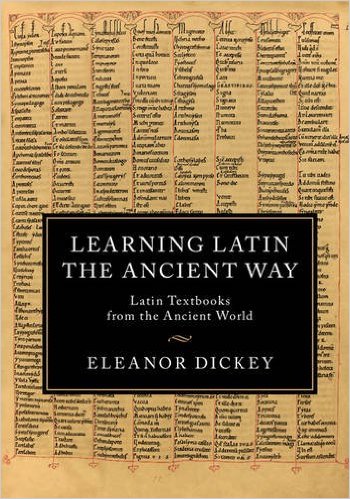Learning Latin the Ancient Way, Reading Classics professor Eleanor Dickey’s latest book published this week by Cambridge University Press, has been reviewed in the Guardian. The review can be seen at http://www.theguardian.com/books/2016/feb/10/ancient-greek-manuscripts-reveal-life-lessons-from-the-roman-empire The book explores how Greek-speaking students in the Roman empire learned Latin, using the fragments of their Latin textbooks preserved on papyri from Egypt and in medieval manuscripts. In some ways these ancient Latin learners had an experience strikingly similar to that of modern students: they used grammars, dictionaries, and commentaries; they read Cicero’s Catilinarian orations and Virgil’s Aeneid; they memorized vocabulary; they looked up the hard words and wrote translations into their Latin texts.
But in other ways the ancient Latin learners had a very different experience from that of their modern counterparts. Some of these differences come from the fact that ancient learners came to Latin knowing ancient Greek rather than English. So they struggled to learn the Roman alphabet, but they had no problems with the distinction between nominative and accusative cases. Other differences come from ancient educational conventions: ancient beginners started off with bilingual texts, easy Latin accompanied by a running translation. Of course the students could not translate the Latin for themselves as a modern learner might do, since a translation was provided; instead they memorized the Latin, rather the way a student studying French today might memorize a dialogue about ordering croissants in a café in Paris.
Indeed the texts read by ancient beginners have much more in common with material read by modern French learners than with that read by modern Latin learners. Ancient students studied short dialogues and narratives about daily life: buying clothes, buying food, having lunch, borrowing money, and visiting sick friends. Of course, ancient daily life was not quite like modern daily life, so the dialogues also cover going to the public baths, winning court cases, making excuses, getting into fights, taking oaths in temples, and coming home drunk after a Roman orgy. Just like their modern counterparts, these dialogues were written to teach students about culture as well as language; therefore they offer us priceless insight into life in the Roman empire as Romans saw it.
Learning Latin the Ancient Way provides extracts from all types of ancient Latin-learning texts: bilingual dialogues, alphabets, grammars, dictionaries, annotated copies of Sallust, word-lists to Virgil, prose composition exercises, Aesop’s fables, stories about the Trojan war, letters of congratulation for sending to successful legacy hunters, an explanation of the Roman law on manumission, etc. Portions originally written in Greek have normally been translated into English, but the Latin remains in Latin; this means that modern students can experience and use these texts as their ancient counterparts would have done (or ignore the English and treat the passages like any other translation exercise). A few passages lack word division and punctuation, to make it clear what reading was really like in antiquity.
Professor Dickey hopes that her book will be used by modern Latin teachers and students (it is suitable for learners who have already done at least one year of Latin) and that it will enable modern learners to enjoy the ancient Latin-learning materials, which are now able to be used once more for their original purpose.
Copies can be purchased from Cambridge University Press (to whom Professor Dickey is very grateful for pricing the book at an affordable £18, a sharp contrast to most of her previous books): http://www.cambridge.org/gb/academic/subjects/classical-studies/classical-languages/learning-latin-ancient-way-latin-textbooks-ancient-world?format=PB.


